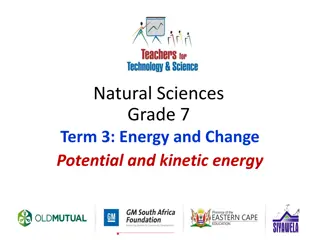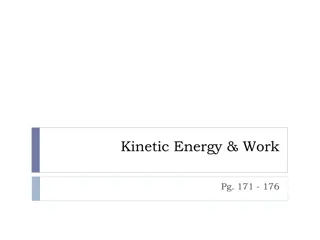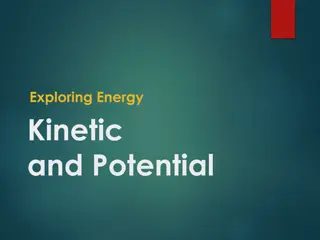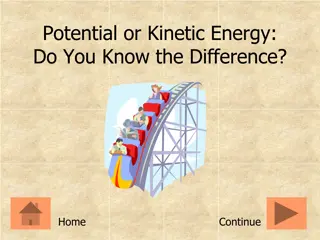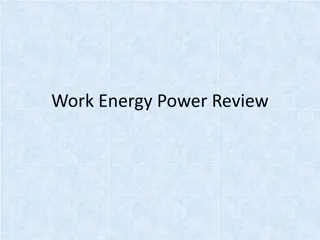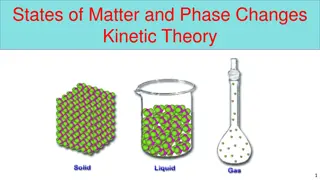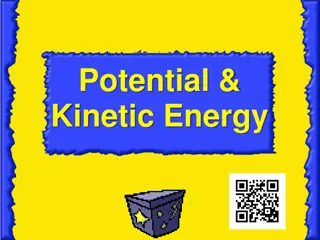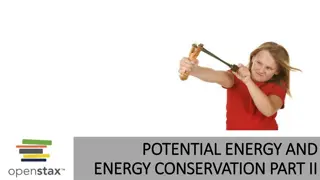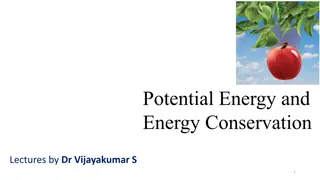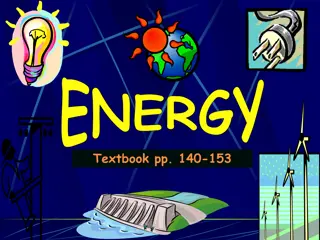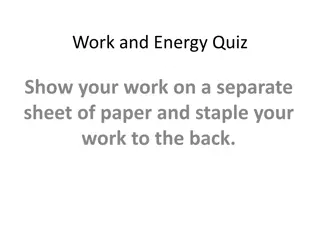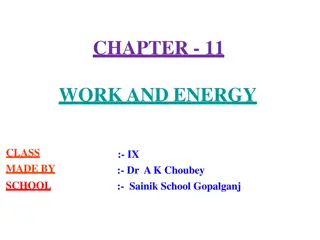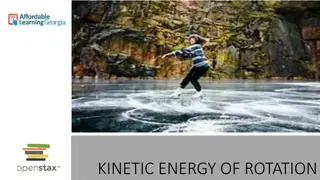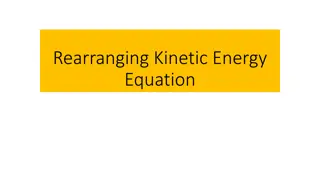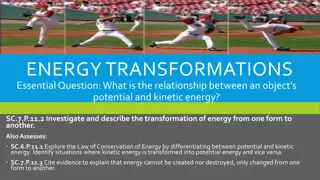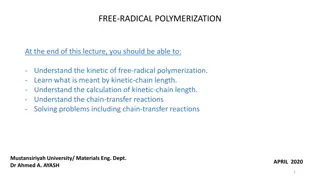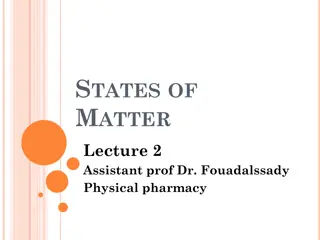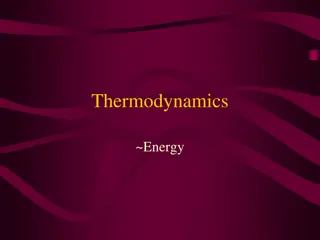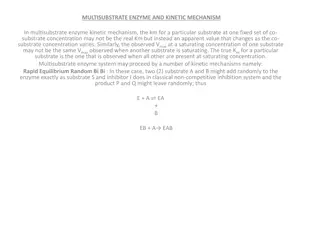Understanding Energy and Work: Kinetic & Potential Energy Concepts
Delve into the world of energy and work with a focus on kinetic and potential energy. Learn how these forms of energy manifest, transfer, and impact our surroundings. Explore the definitions, calculations, and examples related to energy and work in an engaging visual format.
Download Presentation

Please find below an Image/Link to download the presentation.
The content on the website is provided AS IS for your information and personal use only. It may not be sold, licensed, or shared on other websites without obtaining consent from the author. Download presentation by click this link. If you encounter any issues during the download, it is possible that the publisher has removed the file from their server.
E N D
Presentation Transcript
Learning Objectives I can define Kinetic and Potential energy. I can identify Kinetic and Potential energy. I can give examples of the two forms of energy. I can explain how one can transfer to the other.
Work The product of distance and the force in the direction an object moves. Work = Force x Distance
Definition of Energy The ability or capacity to do work. Measured by the capability of doing work: potential energy or the conversion of this capability to motion: kinetic energy.
What is Energy? What is Energy? The ability to cause change Think about things that have energy in them All those things can make something DO something! It s what causes change in everything! Nothing changes without some energy causing it. Earthquakes, Rain, even human growth is all because of energy.
2 types of energy Kinetic and Potential Energy
How is all energy divided? All Energy Potential Energy Kinetic Energy Elastic Potential Energy Gravitation Potential Energy
Potential Energy Energy that is stored due to position or shape. It is stored energy. There are 2 types of Potential Energy 1) Gravitational Potential Energy (GPE) 2) Elastic Potential Energy
Gravitational Potential Energy (GPE) Potential Energy that depends upon an objects height above a reference point Formula: PE = mgh Potential energy is calculated by: The object s mass (m), multiplied by the earth s gravitational pull (g) (9.8 m/sec/sec), multiplied by the height (h) the object can fall.
Formula Representation Formula Represents mass Units m = g = acceleration due to gravity h = height Kilogram (kg) m/s/s PE = mgh Meter (m)
Gravitational Potential Energy Books on a shelf have Gravitational Potential Energy. Which books have the most Gravitational Potential Energy? Why?
Gravitational Potential Energy A man and his cell phone are on a ledge outside a very tall building. Which object (the man or his cell phone) has the most Gravitational Potential Energy? Why?
What does Potential Energy depend on and how does it affect potential energy? Height The higher the object, the more potential energy. Mass The greater the mass of the object, the more potential energy it has. Potential energy depends on both mass and height.
Examples of Gravitational Potential Energy Water at the top of a waterfall.. -Stores energy Yo Yo in held in your hand.. -Stores energy because of position
Elastic Potential Energy (EPE) The potential energy of an object that is stretched or compressed. Examples of Elastic Potential Energy Stretching a rubber band.. -Stores energy Drawing a Bow -Stores energy because of position
Elastic Potential Energy The bow has energy because work has been done to change its shape. The energy of that work is turned into potential energy. When the arrow is released the potential energy of the bow and string will be transferred to the arrow, sending it flying through the air.
Elastic Potential Energy Compressed, or squished, springs also have potential energy. A spring has energy because work has been done to change its shape. Just like the bow, the energy of that work is turned into potential energy.
Elastic Potential Energy What about rubber bands and other things that stretch? Elastic Potential Energy
There are Two There are Two types Potential energy Potential energy: : Potential: stored energy (able or about to do something but isn t just yet) The ball could fall, but it hasn t yet! types of of There are two basic examples of Potential Energy: Gravitational Elastic The boulder can fall but it hasn t yet The bow can shoot the arrow but isn t right now. Elastic Energy is caused by changing theshape of an object ( stretching , bending , pulling , squishing ) Gravitational Energy is caused by the force of gravity Pulling down on an object while the object is being held up!
When the position of an object is altered it, creates Potential Energy. A yo-yo on the table, doesn t have energy, but when picked up, it alters its position and now it has the ability (or potential) to do work. A bow doesn t have the capacity to do work, unless it s held at an elevated position.
Potential Energy Converted to Kinetic Energy When stored energy begins to move, the object now transfers from potential energy into kinetic energy. Standing still Running
Kinetic Energy Preview Kinetic Energy is the energy of motion or energy in use Any matter in motion has Kinetic Energy There are many forms of Kinetic Energy Some forms include: electromagnetic (light - radiant), thermal (heat), electrical, and mechanical (sound acoustic)
Kinetic Energy Definition and Formula The energy an object has due to its motion Formula: KE = 1 2mv2 Kinetic energy is calculated by: Squaring the velocity (v), multiply by the object s mass (m), than divided by 2.
Formula Representation Formula Represents KE = m = mass v = velocity Units Kinetic Energy Joules (J) kilogram (kg) Meter/second (m/s) KE = 1 2mv2
Kinetic energy: Kinetic energy: Kinetic: Energy of movement This container is full of a red liquid But there is a hole! Gravity pulls the liquid down through the hole! The motion of the liquid is an example of a substance with Kinetic Energy Ball falling down = Movement Movement = Kinetic Energy
What is the unit for Kinetic and Potential Energy? Unit: Joule Named after: James Prescott Joule He discovered the relationship between heat (energy) and mechanical work which led to the law of conservation of energy. How do we derive this unit? 1 Joule = 1kg m2/s2 KE = m(kg) v(m/s) 2 PE = m(kg) g(m/s) 2 height(m)
What does Kinetic Energy depend on and how does it affect kinetic energy? Velocity/Speed The faster the object moves, the more kinetic energy it has. Mass The greater the mass of a moving object, the more kinetic energy it has. Kinetic energy depends on both mass and velocity.
Which affects kinetic energy more? Mass or Velocity and why? Velocity has more of an affect on kinetic energy because the velocity is squared.
Examples of Kinetic Energy Shooting a rubber band. Water falling over the fall. A Yo-Yo in motion. Releasing the arrow from the bow.
Potential vs. Kinetic: Potential vs. Kinetic: The Roller Coaster has potential energy at the top of the hill The rocket has potential energy when the fuel hasn t been lit The rocket has Kinetic energy when it s fuel is lit and it flies through the air There s a lot of potential energy in this sucker! Wow! But it has Kinetic energy when it rolls down the hill!
POTENTIAL ENERGY Energy stored or held in readiness Most potential
As a basketball player throws the ball into the air, various energy conversions take place.
Summary of What Youve Learned.. Example using a coin: Holding a coin in you hand, alters the coins original position. The coin has potential energy, because it has ability to do work. Dropping the coin in the bank, changes the stored energy into motion. This transfers the coin s energy from potential to kinetic energy.
Big Ideas 2 main types of energy: Kinetic and Potential Kinetic energy is energy of motion and depends on mass and velocity. Potential energy is stored energy Potential energy has 2 types: Gravitational and Elastic Gravitational potential energy depends on mass and height.


